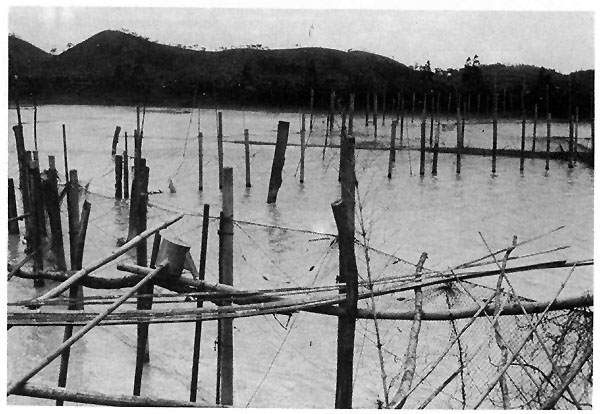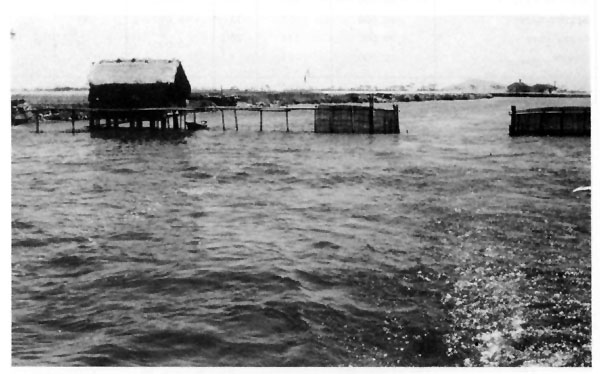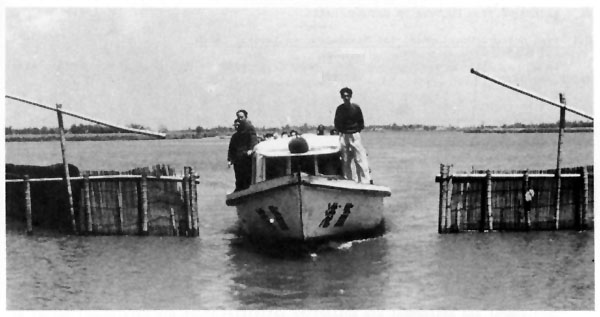In certain provinces in China, mainly in the regions of the Chang Jiang (e.g., Jiangsu and Zhejiang) and Zhu Jiang (Guangdong) deltas, the small rivers and navigable channels can be prepared for extensive fish farming. Outlay is relatively small, usually consisting of the erection of barriers to prevent the escape of fish stocked.
The study group was able to observe this type of fish culture activity on two occassions: development of a small river in the Xinhui district (Guangdong) for fish culture activities and extensive farming in channels at the Annex of the Shaoxing District Fish Culture Centre (Zhejiang).
The Tangxia (Xinhui, Guangdong) People's Commune is concerned with farming a stretch of the main channel of the Tiansha River (20 km) and secondary channels flowing into it (30 km), i.e., 50 km of channel along a total length of 140 km. A part of this farm is operated by the people's commune itself (140 ha) and the rest by five production brigades (approximately 233 ha). The comments below refer to the communal farm.
The boundaries of the farming zone are demarcated by fences made of netting of different mesh sizes. There are five relatively large fences - two in the main channel and three at the mouths of the tributaries. The largest is 136 m long and a maximum of 7 m deep (Figure 51). Thirty-one smaller fences, about 3–4 m long and less than 4 m deep are placed at the mouths of other tributaries. Since navigation has to be allowed in a main channel, a passage fitted with a moveable fence is provided in each of the two fences which have been set up there.

Figure 51 Extensive fish culture in the Tiansha River. Tangxia People's Commune, Guangdong. View of the main fence (136 m) installed in a zigzag across the river
So as not to hinder the flow of the river and in order to reduce the force exerted on the sections of netting which made up these large barriers, they are deployed in a zigzag fashion, the straight line of which is perpendicular to the line of the channel, and their total length is thus increased.
The channels were stocked for the first time in 1974 and annual stocking has been carried out since (Table 33). Large fingerlings (150–250 g) of the four carp species are now stocked once a year, at the rate of 714 fish/ha, to allow extensive polyculture based on bighead (50 percent) and silver carps (40 percent). During the first four years, average harvests were 180 kg/ha/year. In 1979, however, yield increased slightly to 195 kg/ha/year. This earned Y 30 000, a third of which represented the farm's profits. Annual yield from extensive farming in rivers can generally vary between 135 and 645 kg/ha, depending on the sector considered. The results mentioned above are not therefore among the best.
Table 33
Stocking carried out by the Tangxia People's Commune for extensive fish culture in 140 ha of river
| Species | 1974 | 1976–79 | ||||
| Total No. of fish | Density N/ha | % | Total No. of fish | Density N/ha | % | |
| Bighead carp | 60 000 | 428 | 40 | 50 000 | 357 | 50 |
| Silver carp | 50 000 | 357 | 33 | 40 000 | 286 | 40 |
| Grass carp | 30 000 | 215 | 20 | 10 000 | 71 | 10 |
| Common carp | 10 000 | 71 | 7 | |||
| Total | 150 000 | 1 071 | 100 | 100 000 | 714 | 100 |
In most cases, fish culture management is restricted to:
Fertilizing and feeding is rarely done and then only semi-intensively. Some natural fertilizing may however occur from run-off water from cultivated areas.
It would appear that on some occasions, fry for stocking are reared in artificially made pools in the farming areas (ADCP, 1979). These pools are stocked with very young fish (3–4 days old), as soon as they become cut off from the river in the dry season. Semi-intensive fry rearing is therefore carried out until the waters rise again and become automatically stocked. The fry are then sufficiently large (200–300 g) that later mortality is limited to between 20 and 40 percent.
In the district of Shaoxing (Zhejiang), there is an ancient tradition of extensive fish culture in the many navigable channels1 which criss-cross the region. Currently, 12 693 ha are being farmed, either by the State, represented by the district (6 360 ha) and the District's Fish Culture Centre (1 200 ha), or by the people's communes (5 133 ha). The average depth of the water is 3 m.
In order to facilitate management operations, the channels are divided into sections of 40–53 ha, by means of blocking devices made of bamboo and netting. Boats are allowed to pass through a moveable gate which opens and closes automatically or is manually operated (Figures 52 and 53). Management of these sections includes:

Figure 52 Extensive fish culture in navigable channels; barrier separating two sections of the channel, with moveable, manually operated gate and operator's house. District of Shaoxing, Zhejiang

Figure 53 Barrier separating two sections of the channel, with automatic moveable gate. District of Shaoxing, Zhejiang
Stocking is done twice a year, in spring and summer. Depending on the section of the channel involved, 1 800 fish/ha (fry weighing 15 g or 10–15 cm long), or 960 fish/ha (fingerlings weighing 250 g) are stocked. Extensive polyculture of bighead (60 percent) and silver carps (40 percent) is practised. When aquatic plants are available, a limited number of grass carps and Wuchang bream are added. Most of the fry are produced locally in floating cages (Section 5.4). It must be pointed out that the first stocking of a section takes place only after exhaustive fishing of the predatory fish which live there naturally. Thereafter, the relative numbers of these fish are minimal and this level is easily maintained by regular selective fishing.
An average of 300–1 350 kg/ha of marketable fish is harvested annually. The best yields are obtained when the following rules of fish culture management are applied:
This type of management is conducted by the Annex to the Fish Culture Centre of the district of Shaoxing which farms 335 ha of channels. Average annual output up to 1978, was 900 kg/ha. However, improved management practices resulted in an output of 1 125 kg/ha in 1979, i.e., an average increase of 5 600 kg of fish per salaried employee.